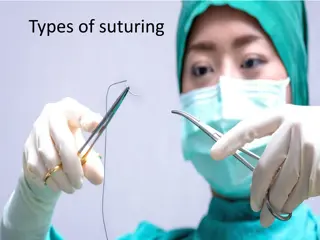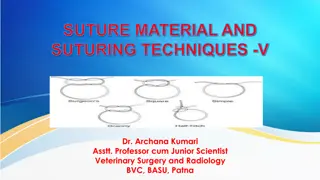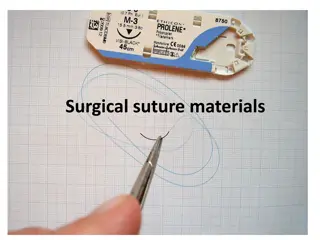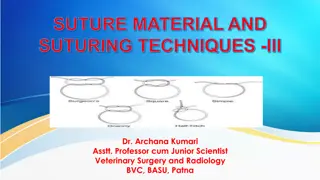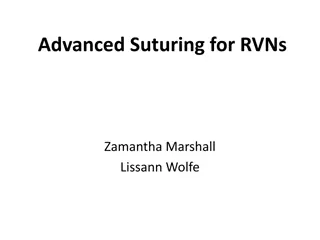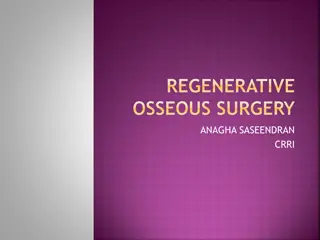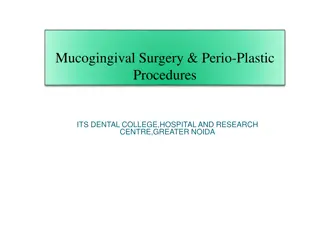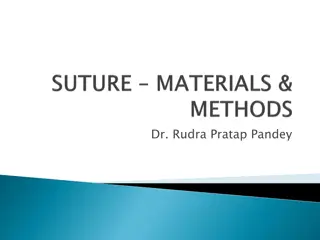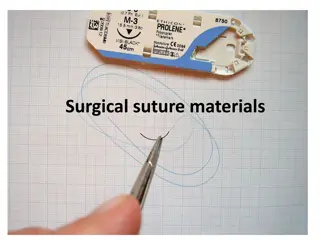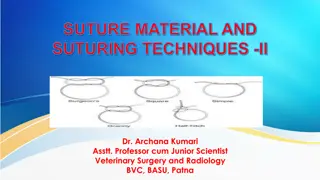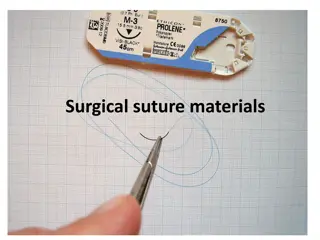Suture Materials and Techniques in Veterinary Surgery
Explore the various suture materials like Polydioxanone, Silk, Horse hair, Linen, and Inorganic materials used in veterinary surgery. Understand their characteristics, absorption times, and potential applications, along with different suturing techniques employed for different surgical procedures.
Download Presentation

Please find below an Image/Link to download the presentation.
The content on the website is provided AS IS for your information and personal use only. It may not be sold, licensed, or shared on other websites without obtaining consent from the author.If you encounter any issues during the download, it is possible that the publisher has removed the file from their server.
You are allowed to download the files provided on this website for personal or commercial use, subject to the condition that they are used lawfully. All files are the property of their respective owners.
The content on the website is provided AS IS for your information and personal use only. It may not be sold, licensed, or shared on other websites without obtaining consent from the author.
E N D
Presentation Transcript
SUTURE MATERIAL AND SUTURING TECHNIQUES -IV Dr. Archana Kumari Asstt. Professor cum Junior Scientist Veterinary Surgery and Radiology BVC, BASU, Patna
Polydioxanone It is synthetic monofilament polymer of paradioxanone. It is sterlised by by ethylene polyglactin 910. It is absorbed by hydrolysis Absorption time 91 to 182 days. On relative basis catgut loses its strength on 7 day, polyglactin at 10-19th day and polydioxanone at 20th day.
Non absorbable (Organic suture material) Silk: Obatined from the cocoon of the silk worm. Dyed with the vegetable dye . Its natural capillarity is decreased by treating it with oil, waxor silicone And it is available as monofilament and braided multifilament. Sterlised by autoclaving, binds with gammaglobulin leads to acute inflammation may cause ulceration in the GIT. May act as nidus for calculus formation in the urinary bladder and gall bladder. Cotton: Less tissue reaction than silk. Capillary in action Silk worm gut: It is smooth ,strong , non capillary and useful for cutaneous suture. It is available in fine , medium, and coarse size 30 to 40 cm length
Horse hair : It is cheap , non-capillary ,flexible and is easily sterlised . It causes little tissue reaction. Linen: It is capillary in nature and produces more tissue reaction than cotton and silk. Umblical Tape: Cotton tape suture is about 1/4 cm wide and most often used to tie the umblical cord of the new born or as vulvar suture in cases of prolpse of vagina or uterus. Dermal suture : Non absorbable silk coated with tanned gelatin or other protein substances.
Inorganic suture material Mettalic suture : Wire of different metals like tatntalum ,silver ,copper, aluminium, vitallium(stainless steel). Metal clips (wound clips): They hold the skin in opposition over flat surfaces. They causes less scarring. Pin suture : Ordinary pins can be used for keeping the skin edges together. Wire mesh: Tantalum and srainless steel mesh are used to cover defects in the abdominal wall in cases of hernia or injury.
Synthetic suture material Nylon: Obtained from hexamethylene diamine and adipic acid. It is biologically inert and may be monofilament or mulifilament, and former is non-capillary. It stimulates minimal tissue reaction . It is not used within serous or synovial cavity because cut sharp ends can cause trauma due to friction . It has poor handling characteristics and knot security. Polyster Fiber Synthetic mesh Terelene Synthetic mesh Polybutester Surgilene Vetafil
Natural Absorbable Non absorbable catgut Silk worm gut Chromic Silk catgut Cotton Collagen Fascia lata Beef tendon
Synthetic Absorbable Non Absorbable Polyglycolic acid Nylone Polyglactic acid Polypropyline Polyglactin(vicryl) Polysters Polydioxanone(PDS Polyethelene
Metallic SS(stainless steel) Tantalum Silver Gold Aluminium
Monofilament Non-absorbable Polyoropylene Polyester Nylone Polyvenyleidenefluoride /PVDF suture Absorbable Catgut Chromic catgut Vicryl PDS
Monofilament vs multifilment Monofilament Has no capillary action Less infection risk Smooth tissue passage Higher tensile strength More throws required Multifilament Has capillary action Increased infection risk Less smooth passage Less tensile strength Better knot security
Absorbable vs Non absorbable Absorbable Degraded by enzymes ,hydrolysis or phagocytosis Used to hold the edges in approximation temporarily until the wound is heal Non absorbable Encapsulated or walled off by fibrosis Used to suture at sites where tensile strength need to be maintained
Selection of suture materials Condition of the wound. Tissues to be repaired. Tensile strength. Knot holding characteristics. Reaction of surrounding tissues.

 undefined
undefined












